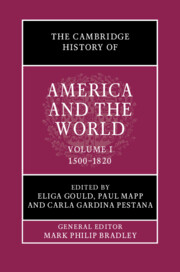Book contents
- The Cambridge History of America and the World
- The Cambridge History of America and the World
- The Cambridge History of America and the World
- Copyright page
- Contents
- Figures
- Maps
- Contributors to Volume I
- General Introduction: What is America and the World?
- Introduction: What Does America and the World “Mean” before 1825?
- Part I Geographies
- Part II People
- Part III Empires
- Part IV Circulation/Connections
- Part V Institutions
- 17 Slavery, Captivity, and the Slave Trade in Colonial North America’s Global Connections
- 18 A Maritime World
- 19 Antislavery in America, 1760–1820: Comparisons, Contours, Contexts
- 20 Women, Gender, Families, and States
- 21 Empires and the Boundaries of Religion
- Part VI Revolutions
- Index
17 - Slavery, Captivity, and the Slave Trade in Colonial North America’s Global Connections
from Part V - Institutions
Published online by Cambridge University Press: 12 November 2021
- The Cambridge History of America and the World
- The Cambridge History of America and the World
- The Cambridge History of America and the World
- Copyright page
- Contents
- Figures
- Maps
- Contributors to Volume I
- General Introduction: What is America and the World?
- Introduction: What Does America and the World “Mean” before 1825?
- Part I Geographies
- Part II People
- Part III Empires
- Part IV Circulation/Connections
- Part V Institutions
- 17 Slavery, Captivity, and the Slave Trade in Colonial North America’s Global Connections
- 18 A Maritime World
- 19 Antislavery in America, 1760–1820: Comparisons, Contours, Contexts
- 20 Women, Gender, Families, and States
- 21 Empires and the Boundaries of Religion
- Part VI Revolutions
- Index
Summary
Slavery connected North American colonies to a wider world in ways both obvious and subtle. Most obviously, forcing African people to toil in the New World introduced African knowledge, cultures, and languages into American societies, enriching not only slaveholders, but also American culture. African labor, skills, and traditions built American economies, shaped systems of production, and transformed American cuisine, music, and speech. Meanwhile, North American colonists adapted slavery’s caste system from precedents set elsewhere around the Atlantic. Slaveholding North American societies codified and elaborated systems to control the enslaved to suit their own ends and circumstances, articulating a racial division of rights and labor that uniquely constrained African American lives and subjected enslaved people to myriad abuses, but the basics of property in persons and hereditary servile status were imported.
- Type
- Chapter
- Information
- The Cambridge History of America and the World , pp. 381 - 402Publisher: Cambridge University PressPrint publication year: 2022

